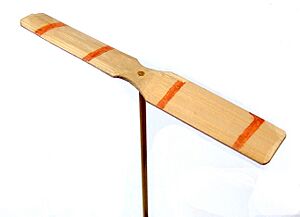Bamboo-copter facts for kids
The bamboo-copter is a cool toy that flies! It's also known as the bamboo dragonfly or Chinese top. You spin its stick really fast between your hands, and it flies up like a tiny helicopter. This amazing toy first appeared in ancient China around 320 A.D. Later, an English engineer named George Cayley, who helped invent modern aeronautics (the science of flight), studied it.
Contents
The Bamboo-Copter: An Ancient Flying Toy
The earliest flying toys in China were simple. They had feathers attached to a stick. People would spin the stick quickly between their hands and then let it go, watching it fly. Even though it was just a toy, many people see the Chinese top as one of the very first devices that looked like a helicopter.
Early Ideas of Flight in China
Around 317 A.D., a Chinese philosopher named Ge Hong wrote a book called Baopuzi. In this book, he mentioned ideas about flying vehicles. He described "flying cars" made from wood with "revolving blades" that moved with straps. Some experts believe he was talking about early helicopter-like toys or even bigger flying machines. These ideas show that people in ancient China were thinking about how to make things fly a long time ago.
How the Bamboo-Copter Traveled West
This Chinese helicopter toy eventually made its way to Europe. You can even see it in some old European paintings and drawings! For example, a French painting from around 1460 shows the toy. It also appears in a stained glass panel from the 1500s in London. A famous painting by Pieter Brueghel the Elder from about 1560 even shows a helicopter top with three propellers.
Inspiring Modern Flight
In China, the bamboo-copter was mostly for fun. But in the West, it became a key part of how modern flight began! Scientists in Europe started to create flying machines based on this simple Chinese toy.
Western Scientists and Their Flying Models
- In 1743, a Russian scientist named Mikhail Lomonosov made a spring-powered model with two propellers spinning in opposite directions.
- A French scientist, Christian de Launoy, created a device that used a bow drill to spin feather propellers.
In 1792, George Cayley began his own experiments with these helicopter tops. He called them "rotary wafts" or "elevating fliers." In 1809, he wrote an important article called "On Aerial Navigation." In it, he showed and described a flying model. This model had two propellers made from corks and feathers, powered by a whalebone bow drill. Cayley improved his models a lot. He noted that while the original toy might only fly about 20 to 25 feet (6 to 7.5 meters), his improved versions could go over 90 feet (27 meters) high! This made his models direct ancestors of today's helicopter rotors and aircraft propellers.
The Legacy of the Bamboo-Copter
The British scientist and historian Joseph Needham studied Chinese inventions. He noted that some inventions, like the helicopter top, started as simple curiosities. Even though the bamboo-copter didn't immediately lead to the invention of the helicopter in China, it planted an important seed. It showed that spinning blades could create lift, inspiring inventors centuries later to develop the amazing flying machines we have today.
See also
 In Spanish: Taketombo para niños
In Spanish: Taketombo para niños



